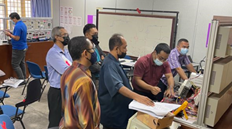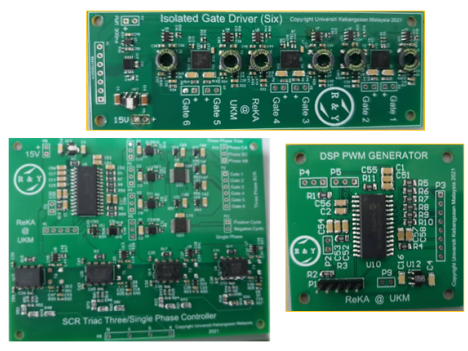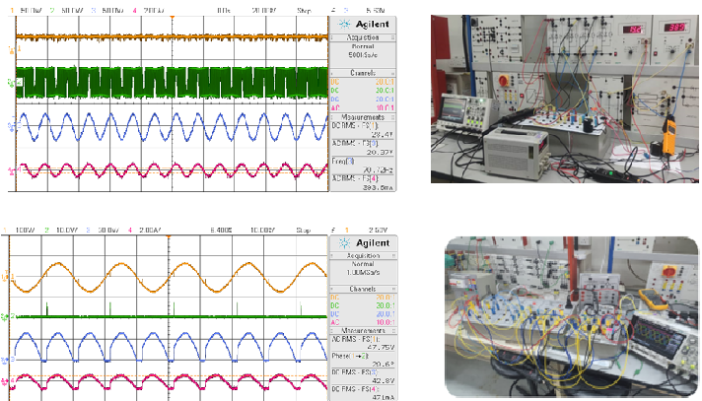Power Electronics Learning Equipment (PELE)
Alat Pembelajaran Elektronik Kuasa
Relevance of the Innovation
The innovation is related to electrical and electronics engineering program offered in many universities and technical (vocational) colleges around the world particularly in the Asia-Pacific region. Power electronics is a core course for electrical and electronics engineering program primarily for undergraduate studies. The power electronics learning equipment (PELE), can be considered as the latest development of gating signal generator which uses the latest powerful and reliable digital signal processing (DSP) device technology as its main brain. The DSP is embedded with a simple intelligent algorithm to generate accurate gating signals for AC-AC, AC-DC, DC-DC and DC-AC power converter circuits. Since PELE is dedicated for power electronics course, therefore the sustainable development goal 4 (SDG 4) substantially met with the intended goal which are providing quality education and promoting lifelong learning opportunities. Malaysia is a country located at Asia-Pacific region and also an active UNESCO member state. Thereby, PELE is a specific educational innovation for learning recovery because after two years pandemic Covid-19 prevailed, it has coming to an end, resulted in the students is free to continue conducting power electronics experiment without fear.
Timeliness
In the end of November 2022, a company called Akar Inovasi Sdn Bhd approached us to offer a task as a trainer to teach and demonstrate a few sets of electrical machine and power electronics laboratory equipment imported from oversea to the lecturers of a polytechnic in Kedah, Malaysia. Based on the feedback, the client wanted the company to improve the performance of gating signal generator circuit. After some negotiation, an agreement was reached to develop a new circuit with better performance through a letter dated 22nd December 2021. The company funded the development of the circuit, and it was completed a month later. It featured a better performance with new panel appearance and laboratory manuals. The process taken to develop the circuit was not so difficult because the design was similar to the ongoing research.
Effectiveness
This innovation is called PELE, acronym for power electronics learning equipment. Basically, it is a gating signal generator circuit, consist of three components which are pulse width modulation (PWM) circuit, SCR/Triac trigger circuit and isolated gate drive circuit respectively. Power converter circuit comprises of AC-AC, AC-DC, DC-DC and DC-AC conversion. In order to turn-on and turn-off the power switches that govern the operation of power converters, gating signal is needed. In other word, without the gating signal the power converter cannot be applied. The issue in power electronics course is mainly due to students cannot fully understand the theoretical lesson in classroom without having to conduct the related experiment. Since this course is multi-discipline, it requires a great effort and practical experience to master it. Other challenges are the experiment equipment is expensive, and each year it gets damage due to human error and obsolete problem. Usually fund to acquire a new equipment does not come every year, sometimes it takes more than 10 years to be replaced, depends on budget. Therefore, lecturers need to find alternative approach to fix the issue, such as developing a new equipment and getting support from the industry for example.

Coaching
at POLIMAS
Beneficiaries and Impacts
The main beneficiaries are electrical and electronics engineering students and lecturers UKM. Others are researchers, industries players, government servants, school students and teachers etc. Since the innovation is made in Malaysia, hence this nation is the main beneficiary nation. Based on works and experience related to the innovation, many people have been involved directly and indirectly such as polytechnic lecturers and technical staffs; company manager, engineers, and technicians; UKM students, academicians, and technical staffs; as well as visitors and evaluators at innovation competition. In term of numbers, until now already engaged and expected to engage are UKM students 55 persons, while UKM lecturers 4 persons, they conduct the experiment and final year project using the PELE. Together 3 researchers and 2 technicians from UKM involved actively in designing and constructing the PELE. As many as 5 polytechnic lecturers and technicians have experienced with PELE. In addition, 5 engineers and technicians from Akar Inovasi Sdn Bhd directly involved in development of PELE. At KNOVASI 2022, an international innovation competition, at least 5 individuals knew about PELE during presentation which consist of evaluator and other presenters. All of them are local Malaysians of course, except one Indonesian student. The short- term benefits are strengthening the students’ understanding in power converter circuits operation by experiencing a compact user-friendly and cost-effective equipment, with simple implementation for experiment. Its potential also can be benefited the industrial sectors through training their workers, system development/testing, or verification of self-developed power converter performance. For long-term impact, commercialization of PELE will generate income directly to UKM, innovator and company as well as indirectly spill over effect to the communities. Students can deliver the knowledge and experience obtained from PELE to communities by contributing to the nation development and prosperity as a sustainable long-term impact.
Engagement of Stakeholders and Partners from Different Sectors
Stakeholders consist of innovator/researcher, funder (company) and UKM as employee of innovator and main user (students). All has contributed a significant effort to the successful of PELE. Not to forget the client contribution who request to build a new gating signal generator circuit to replace the problematic previous circuit. Lesson learned from a faulty equipment is an opportunity to take the challenges and to demonstrate one capability to solve the problem and to gain people trust. If succeeded, it will open other opportunities and boost one self-confident. Starting from teaching assistance assignment, has disclosed a new adventure in the form of developing a working PELE for company to the client. The company without hesitate funded a considerable amount of money to develop PELE, aside from technical support. The employee encourages the cooperation between researchers and industrial partner. The objective is to create strategic partnership with private sectors and other government agencies. This will bring experts from the campus to the community by assisting, advising, and supervising their partner in tackling their problem. Indeed, this approach gives mutual benefits to both parties by sharing idea and expertise, providing fund, as well as saving time and resources.
Originality
Key feature of PELE is the use of digital signal processing (DSP) technology that enable fast, stable, efficient, and accurate gating signal to be produced. The DSP is a powerful microchip that calculates digitized binary numbers in a very short time. With DSP, complex and lengthy mathematical expression can be executed easily by writing concise program. PWM, isolated gate driver, and SCR trigger circuits were developed. Both PWM and SCR trigger circuits apply DSP as the processing and controlling unit. On top of that, surface mount devices (SMD) were utilized to increase efficiency while reducing the size of components. Therefore, the circuit layout looks simple making printed circuit board (PCB) size compact, resulting in size and weight of PELE minimized significantly and portable. Another highlight of PELE is isolated gate driver which features double layer galvanic isolation from surge current, thus increasing electrical safety and life expectancy of PELE. Its panel display is interactive, visible, and user-friendly, resulting in easy wire connection. PELE’s power consumption is very low, cost effective with free maintenance, thus suitable for low budget client. Additionally, PELE can be applied to other power electronics application i.e., motor drive, renewable energy, battery charger etc.

Sustainability, Scalability and Replicability
There are several factors should PELE become sustainable in the long-run. Firstly, power electronics course must be taught in electrical and electronics engineering program at universities and polytechnics. Secondly, laboratory experiment for power electronics course is sustained and upgraded. Thirdly, encourage electrical and electronics engineering students to take power electronics course. Finally, promotes and supports prospective students to further study in power electronics research. Therefore, in the long-run PELE will be relevant if it is upgraded and up-to- date accordingly from time to time. Scaling-up the utilization of PELE is difficult, since PELE is a specific educational equipment, its usage is limited. However, its component like isolated gate driver and PWM circuits continuously having a lot of demands especially in electronics industry. Thus, to scale-up these components surely needs extra resources and investment. Since the purpose of PELE development is to serve better education for all, cooperation and partnership between different institutions, stakeholders’ group or even countries by replicating PELE are most welcome. With the existing cooperative partnership, hopefully more initiatives regarding PELE upgrade and reach can be realized, so the objective to educate more students and engineers throughout the world becomes easier.

Award Certificate
PELE PCB modules

Results and Experimentation
